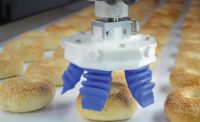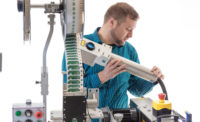Advanced packaging materials improve snack and bakery products
Consumer convenience, food safety, sustainability and desire for longer shelf life drive innovations












Manufacturers today face many challenges when it comes to designing packaging materials for the snack and bakery market, especially as the consumption cycle of packaged foods grows longer. The demand for clean labels continues to increase, and consumers want healthy snack foods in easy-to-access formats that reflect a healthy image.
Consumers seek packaging formats and sizes specific to their needs at a given point in the day, says Tom Egan, vice president of industry services, The Association for Packaging and Processing Technologies/PMMI, Reston, VA. “Walking down the snack food aisle, it is evident that pouches of all types are a prime packaging format to address these consumer desires. The resulting SKU explosion requires manufacturers to quickly juggle their packaging and processing operations to handle varied product formulas, multiple ingredients, different package sizes and even package printing.”
The growing use of online shopping is another factor. As online shopping continues to gain popularity among all target audiences, grocery is the category expected to receive the largest share of growth, according to research conducted by Food Marketing Institute and Nielsen, which predicts that 70 percent of consumers will be grocery shopping online by 2024.
For snack producers and bakeries, the rise in online grocery shopping poses new challenges, such as product protection, containment and sustainability, says Richard Custer, specialty commercial director, Presto Products Co., Appleton, WI. “Ensuring the product is intact during the final moment of truth—the period in which a consumer opens the package they’ve been waiting for and sees their ordered item—is as important as the quality of the product itself.”
As this trend continues, packaging materials will need to evolve to handle all the touchpoints of e-commerce, according to Holly Dunnill, North America marketing director, Dow Packaging & Specialty Plastics, Midland, MI. “Flexible packages that incorporate Dow’s INNATE family of resins are well suited to handling these multiple touchpoints and shipping in the e-commerce channel. INNATE resins provide film stiffness needed for efficient filling, displaying and storing of packages, such as stand-up pouches. They also are designed to extend shelf life, helping to keep foods protected longer to reduce food waste.”
Material innovations
The creation of clean labels, which involves the removal of preservative and additive food ingredients, poses challenges, as well. Removing preservatives from snack and bakery products can shorten their shelf lifew—unless the packaging contains high-performance barriers to offset that process.
Developments in active packaging technologies that extend product shelf life continue to evolve, extending shelf life, and adding convenience and freshness to food products. For instance, it has been proven that adding nitrogen and CO2 to food packaging, and keeping oxygen out, helps prevent spoilage.
Sealed Air, Charlotte, NC, works with bakeries throughout North America to extend shelf life and improve quality through the use of specialty films, says Scott Corey, director of marketing. “Active barrier films combined with modified-atmosphere packaging (MAP) are able to extend shelf life, improve food quality and help bakeries eliminate freezing, which has a significant impact on the quality of baked goods. According to many sources, as much as 40 percent of bakery products are wasted or never consumed. Extending shelf life reduces waste, which has a positive impact on bakery production and distribution models.”
Consumers often benefit from post-purchase packaging advances to help preserve product freshness—another method of helping prevent food waste. Innovations in closing and resealing packages, which offers convenience while sealing in freshness, represent a key development. For example, Sealstrip Corp., Gilbertsville, PA, has introduced SealAcross, an easy-open, tamper-evident, resealable label applied across the packaging film, which opens along the package’s full width at the end seal.
Because SealAcross is a thin material extending along most of the width of the packaging film, the resulting pre-applied rollstock is even, smooth and flat. It does not affect packaging machine settings or speeds, according to Jo Anne Forman, director of product development. “When packagers think of a pre-applied feature in rollstock, they may think of zip features, which add bulk and create unstable rollstock that is a challenge for operations to run on a packaging machine. In contrast, SealAcross rollstock is flat and smooth.”
As consumer demand for smaller pouch sizes increases across multiple snack and bakery categories, small-format slider systems for flexible package closure are available to meet this need, says Custer. “The new Fresh-Lock mini Slider from Presto Products Co. provides a solution for converters and consumer packaged goods brands that in the past could only utilize press-to-close zipper solutions on pouches with small openings. Sliders add more assurance that the package is completely closed.”
Sustainability perspectives
Flexible packaging offers a number of sustainability benefits throughout a product’s life cycle when compared to other formats. These benefits range from material reduction, light weight and source reduction to shelf life extension, fewer materials to landfill and a higher product-to-package ratio. In fact, sustainability is a key driver of current innovation.
Research conducted by PMMI shows that consumer desire for sustainable packaging is growing especially among younger consumers, but that science has not completely caught up yet. For example, many multi-layered, see-through materials are not recyclable in the current waste stream. “While sustainability is not, at this time, the driving consideration for consumers from a purchasing standpoint, a recent PMMI study shows that consumer packaged goods will improve sustainability of packaging in the next two to three years,” Egan says.
Some manufacturers are already moving in that direction. “Flexible packaging offers lighter weight and other benefits, but due to the packaging structure—multi-layer and multi-material—it is rarely recyclable in today’s collection streams. However, Dow’s Recycle Ready structures are approved for the How 2 Recycle label and enable flexible packaging to be recycled in store drop-off locations around the country,” Dunnill says.
Sealed Air has entered into an agreement with Kuraray America Inc. to offer food packaging materials derived from Plantic bio-based resins. The materials provide a highly effective oxygen barrier that also is cost-competitive with traditional rollstock barrier films. Sealed Air will first offer Plantic materials to package perishable foods, such as poultry, beef and seafood, in the U.S., Canada and Mexico. “Sealed Air is working on applications for this new renewable film in the bakery industry, as well,” Corey says.
Tielman Group, Toronto, has developed a laminated greaseproof paper that allows consumers to replace aluminium foil and plastic-coated board materials with paper. The material withstands baking at high temperatures and deep freezing, and functions well in microwave ovens. It also is fully biodegradable and allows bakeries to improve food safety by using metal detecting in their final quality checks.
“The paper, which is used for baking cups, is tested by an independent laboratory and approved for food contact,” says Ivana Alilovic, global marketing director. “All materials are Forest Stewardship Council certified, meaning they come from responsibly managed forests. Eco-credentials are playing an increasingly large role in consumers’ and businesses’ purchasing decisions, and paper is still viewed as the most environmentally friendly material.”
European initiatives
Two key food packaging initiatives are taking place in Europe. The EU has awarded the international NanoPack consortium €7.7 million to develop a solution for extending food shelf life by using novel antimicrobial surfaces. Comprised of 18 partner organizations, the three-year project is aimed at testing food packaging products with antimicrobial surfaces based on natural materials.
Andrew Manly, communications director, Active & Intelligent Packaging Industry Association, Utrecht, Netherlands, says progress in being made in the development of antimicrobial flexible packaging that incorporates nano-materials, with tests on bakery and bread products extending shelf life considerably. “The active polymer films developed by NanoPack present a very effective antimicrobial and barrier technology, often derived from natural sources, such as essential oils,” he says.
The Circular Economy for Flexible Packaging (CEFLEX) project is a key initiative that could improve sustainability, according to Manly. A collaborative effort of a European consortium of companies, the project’s goal is to evaluate the entire value chain of flexible packaging. The project was launched following concerns that the hard-to-recycle waste stream is not being properly handled. Flexible packaging often is made from laminated layers, which can be difficult to separate, causing problems when it comes to recycling this type of material.
According to CEFLEX, the project has “the ambition to make flexible packaging even more relevant to the circular economy by advancing better system design solutions, which results from the value chain collaboration of the consortium.” The ultimate aim is to develop a collection, sorting and reprocessing infrastructure for flexible packaging across Europe by 2025.
Looking for a reprint of this article?
From high-res PDFs to custom plaques, order your copy today!












